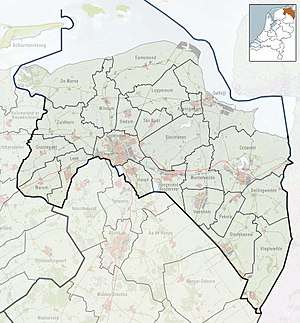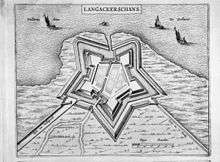Bad Nieuweschans
Bad Nieuweschans (Dutch pronunciation: [bɑt niuʋəsxɑns]) is a village with a population 1,510, located in the north-eastern Netherlands on the border with Germany. It forms part of the municipality of Oldambt. Nieuweschans means "new fortification (sconce)". In 2009, the word Bad ("spa") was prefixed to the name of the village to promote it as a tourist destination.
Bad Nieuweschans | |
|---|---|
 Bad Nieuweschans in 2005 | |
 Bad Nieuweschans Location of Bad Nieuweschans in the province of Groningen | |
| Coordinates: 53°10′50″N 7°12′26″E | |
| Country | Netherlands |
| Province | Groningen |
| Municipality | Oldambt |
| Population (1 January 2004) | 1,510 |
History

The fortification of Nieuweschans was built in 1628, during the Eighty Years' War.[1]
Nieuweschans was a separate municipality until 1990, when it became a part of the municipality of Reiderland.[2] In April 2009, the municipality of Reiderland changed the name from Nieuweschans to Bad Nieuweschans, to promote the town as a spa. On 1 January 2010, Reiderland in turn became a part of the municipality of Oldambt.
Geography
Bad Nieuweschans is located at 53°10′50″N 7°12′26″E in the municipality of Oldambt in the east of the province of Groningen in the northeast of the Netherlands.
Close to the village is the easternmost point of the Netherlands on the border with Germany.
It is located about 12 km east of Winschoten.
Transportation
The Bad Nieuweschans railway station is located on the Harlingen–Nieuweschans and Ihrhove–Nieuweschans railways in the northeast of the village.
Georges Simenon's novel Maigret and the Hundred Gibbets starts in the railway station.
References
- De vesting Archived 16 August 2016 at the Wayback Machine (in Dutch), Stichting Vesting Oudeschans. Retrieved 31 January 2017.
- Ad van der Meer and Onno Boonstra, Repertorium van Nederlandse gemeenten, KNAW, 2011.
External links
- J. Kuyper, Gemeente Atlas van Nederland, 1865-1870, "Nieuweschans". Map of the former municipality, around 1868.
